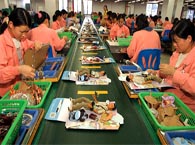Toy industry prays it will be recession-proof
 Berlin - When toy manufacturers unveil the new playthings of 2010 this week at the Nuremberg Toy Fair in Germany, many will be silently praying that the industry will be recession-proof.
Berlin - When toy manufacturers unveil the new playthings of 2010 this week at the Nuremberg Toy Fair in Germany, many will be silently praying that the industry will be recession-proof.
"People reduce all sorts of other expenses before they cut spending on their children," observes Otto Umbach, chief buyer for a cooperative of German toyshops, Idee und Spiel, before the event.
The annual fair is the top showcase in an industry which is dominated by Chinese manufacturers and which has gained most of its growth in recent years in emergent markets such as India and Brazil.
A total of 221 Chinese exhibitors will show goods at the fair, along with 116 US toymakers. Germany will have 876 exhibitors, but many of them are tiny companies with no significant world presence.
With world trade in trouble as a slump spreads round the globe, the industry is expected this year to focus on the tried and true, dolls for girls and cars for boys, while trying to gain an edge with new technologies and features.
Among technologies that look set to carve out new space this year is an advanced new sort of remote control for radio-controlled toys.
The controls use 2.4-gigahertz radio links, which are already common to connect computers with keyboards wirelessly and are more reliable that earlier radio links when steering toy trains and cars.
Manufacturers can build more lights and noises and other features into the toys, because the 2.4-gigahertz radio band can transmit more commands from a child's hand-held console to the toys, yet two or more remote controls do not interfere with one another.
Umbach says keeping it simple is a big part of what children expect and adults ask for.
The industry slogan is "ready to run," meaning a toy helicopter, for example, can be unwrapped, switched on and immediately flown without any complicated setting up.
Amid so much advanced technology, Barbie, who turns 50 this year, is re-assuringly old-fashioned without any hint of being frumpy.
The unnaturally skinny, blonde, dress-up doll was launched at a New York toy fair in 1959.
Its US manufacturer, Mattel, will be unveiling details at the February 5-10 Nuremberg Toy Fair of 50th-birthday promotional offers in many countries of the world and hoping to win back market share from MGA Entertainment's Bratz dolls launched in 2001.
The Bratz line is in trouble after a US court in December ordered it removed from sale by this February and awarded Mattel 100 million dollars in damages against MGA Entertainment for copyright infringement and breach of contract.
MGA Entertainment is appealing and says on its website that it has won a stay till the end of this year in the court order, so "that business is back to normal with Bratz for
2009."
Both series of glamour dolls have been assailed by feminists and supporters of family values, but toy retailers say little girls remain addicted to the toys, devoting hours to dressing them and combing their hair.
The most popular Barbie model of all time, according to Mattel, was Totally Hair Barbie, a version introduced in 1992 with hair that stretches almost to the feet of the
30-centimetre doll.
Historic Barbie dolls are now collectors' items: specimens of the 300,000 original "Barbie Millicent Roberts" dolls from 1959 can change hands for 27,000 dollars if still in mint condition.
Mattel says that counted by the number of doll costumes it sells per year or the 100 million metres of fabric made into Barbie fashions in the past half century, it is one of the world's top clothing brands.
Multi-talented Barbie has exercised 108 professions including flight attendant, TV cook and surgeon in her "lifetime." (dpa)